Exercise is springboard to recovery for cancer patient
Courtesy of USA TODAY 
Shannon Miller's competitive spirit and life-long love for exercise are helping her fight the brave fight again. This time, beating cancer is her mission.

Shannon Miller's competitive spirit and life-long love for exercise are helping her fight the brave fight again. This time, beating cancer is her mission.
"A friend said to me: 'This cancer diagnosis is like being on the balance beam. You fall off. You get back up.' "
The
former Olympic gold-medal gymnast is "back up" after being diagnosed
with a germ cell malignancy, a form of ovarian cancer, in December. She
started nine weeks of chemotherapy March 9 after doctors removed a
baseball-size cyst and an ovary. And she started an exercise program
that she follows faithfully, even during treatment.
Experts
say she is on the right track: assisting her treatment by exercising.
Many of the 12 million cancer survivors in the USA also would benefit,
they say.
"There is a growing body of research
showing exercise not only helps with the side effects of treatment but
also decreases the recurrence risk and improves overall survival," says
researcher Melinda Irwin, an associate professor of epidemiology and
public health at Yale.
"My prognosis is good,"
says Miller, 34. She says her doctors have said they're hopeful that
she and her husband, John Falconetti, will be able to have more
children. Their son, Rocco, is 15 months old. The family lives in
Jacksonville near John's parents, who, along with friends, help with
Rocco on treatment days.
Miller concedes it
isn't easy. She says there are many days she just wants to lie in bed,
usually during the first week of a three-week treatment cycle. That's
when she has five straight days of chemotherapy for five to six hours a day. The other two weeks, she has chemo one day a week.
Nutrition can be a problem. She says she always
has had a tendency to become dehydrated, and at one point, she ended up
in the hospital because of dehydration after a round of chemo.
Exercise isn't always possible, but more often than not, she says, she finds time to be on her exercise mat at home.
"I
find exercise is really helping me with the nausea and fatigue and
helping me regain control of my life," says Miller, who won two gold and
seven Olympic medals overall in 1992 and 1996.
She
says her physical activity also helps her with "chemo brain," a
fogginess that can cause forgetfulness and lead to depression.
A far cry from Olympic workouts
The level and kinds of exercise Miller does are endorsed by the American Cancer Society and the National Cancer Institute.
"People think. 'Oh, she's an Olympian. She's probably doing three-hour workouts.' That's not the case at all," she says.
After
getting a green light from her physician, Miller began a routine in
which she spends 10 to 15 minutes a day doing yoga, lifting 2- to
3-pound weights and walking or swimming. She says she gets winded and
has to listen to her body, "which I got very good at doing as an
athlete, learning when to rest and when to push it."
The
2006 American Cancer Society guidelines on nutrition and exercise say
patients receiving chemotherapy and radiation therapy who are already on
an exercise program may need to exercise at a lower intensity and
progress at a slower pace temporarily, but the principal goal should be
to maintain physical activity as much as possible.
Epidemiologist
Larry Kushi, ACS spokesman, says the organization is in the process of
updating the 2006 guide and will expand on the benefits of exercise. He
adds that he's unaware of any research showing exercise has a negative
impact on cancer treatments.
"She's totally
doing the right thing," says Yale researcher Irwin, who is a former
competitive gymnast herself, "but not nearly as good as Shannon Miller."
The research behind it
Irwin
says the verdict is still out on how exercise benefits cancer
survivors, but she notes studies in which breast cancer survivors who
exercise have lower levels of insulin, and some studies have shown that
high levels of insulin strongly increase the risk of breast cancer
recurrence and death.
Her National Cancer
Institute-funded trial involving 230 sedentary women diagnosed with
ovarian cancer is examining the impact of exercise on quality of life,
fatigue and survival.
"Our study is the
largest exercise trial in cancer survivors," she says. It will provide
critical information in understanding the potential mechanisms through
which physical activity may affect ovarian cancer risk and prognosis,
including what roles estrogens, insulin and insulin-like growth factors
might play.
In a 2008 study in which she
participated, Irwin says, "we not only showed an improvement in survival
from breast cancer, but survival from other causes, such as
cardiovascular disease and diabetes, so exercise is really associated
with a multitude of benefits."
Miller says she
has kept up with the research on exercise and cancer, but that hasn't
been the driving factor behind her workouts.
Even
before her diagnosis, she had long been an advocate for healthy living.
She started her own business, Shannon Miller Lifestyles, after getting a
marketing degree from the University of Houston and a law degree from Boston College. The focus is on fitness, health and nutrition, and pregnancy and motherhood.
She is an author and motivational speaker, and she has continued her radio show on SML Radio during her treatments.
Her son 'keeps me going'
Being
an avid journal writer has helped Miller lately. She has kept journals
for as long as she can remember, she says, but now, outlining her
treatments, diet and workouts has helped her feel she has regained
control of her life. She's featuring her writings on her website,
documenting her journey through chemotherapy.
"I
have trouble remembering what works and what doesn't," she says. "I
write everything down. That way, when you're having a bad day, you can
look back and see what you did that might help you have a good day
again.
"Sometimes even looking back and knowing you had a good day is a big boost."
And being a mom has helped as well. By far, walking with her toddler to the park is her favorite way to get her exercise.
"People
think it must be tough with a small child," she says. "But he keeps me
going. He loves to walk. He holds onto my hand and walks to the park
with me. We can't slow him down."
Rocco certainly plays a role in her weight-lifting routine as well, she says.
"Anyone with a toddler knows you have to be able to pick them up and carry them around," she says. "So I need to stay strong.
"Plus, this will get me back on my feet faster once the chemotherapy is over."
chemotherapy. Experts agree that many cancer patients can benefit from following her example.
10 Best Workouts for Your Sex Life
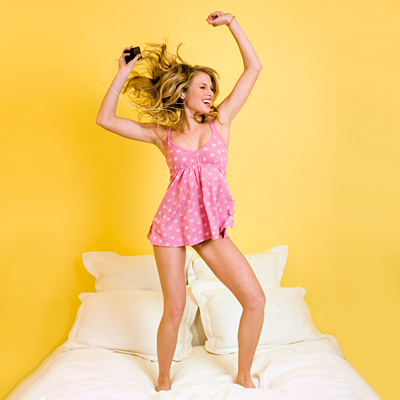
Sexy exercises
By Sarah KleinIt's no secret that exercise boosts your mood, jump-starts your sex drive, and improves your overall health. But that still doesn't always get you to the gym.
So what could be better than a workout that takes your mind off the fact that you're working hard to burn those calories?
"Sexy workouts help us tune into our bodies in a sensual way, so we feel more receptive and more interested in sex," says Marianne Brandon, PhD, a clinical psychologist and sex therapist in Annapolis, Md.
Apart from doing the deed itself, these 10 exercises are the sexiest ways to break a sweat. They'll get your heart racing—in more ways than one!
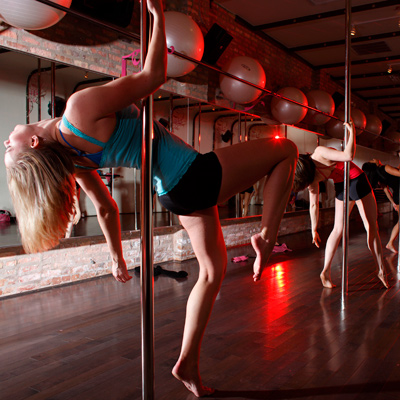
Pole dancing
No longer just for exotic dancers, pole-dancing classes have sprung up around the country—and appear to be here to stay. Private studios and nationwide gym chains alike offer lessons, no experience necessary.For women with flagging libidos, it can even act as treatment. "I often recommend this with my patients as homework," says Brandon.
Just don't expect it to be a walk in the park! Sessions can involve hours of strength work (how else do you stay on the thing if not for clenched muscles?) and sultry swiveling to upbeat tunes.
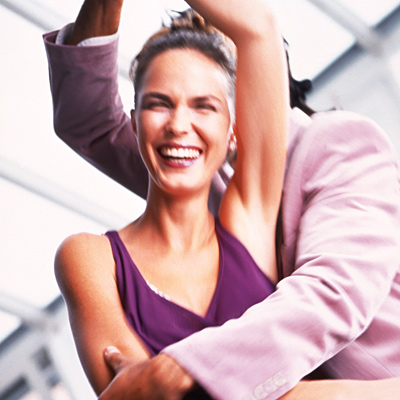
Salsa lessons
Hit the dance floor for steamy salsa lessons and burn 200 calories in half an hour. You don't need to be a great dancer—classes across the country are full of people of all backgrounds and levels. Plus, a workout where you get to don a flirty dress and racy heels can't be bad!To really stoke the flame, grab your significant other and take a lesson as a couple. Studies show partners who try something new together reap big benefits both in and out of bed!
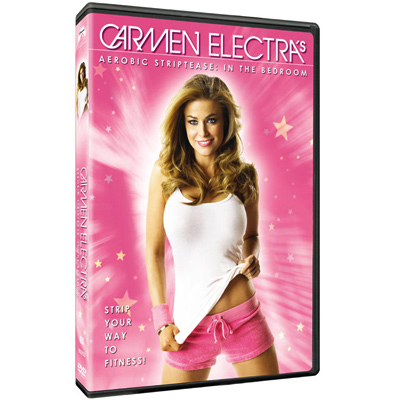
Strip aerobics (cardio striptease)
You don't have to look like Carmen Electra to test-drive her striptease-as-cardio workout plan. And don't worry—you don't actually take all your clothes off!This class is more about sexy, stripper-like moves than disrobing—although you can feel free to peel off a sweatshirt or T-shirt, if you want to.
While strip aerobics could still seem intimidating, devotees stress it's fun and sexy at any size or shape. Join a class where a choreographer can help you learn the steps, or slide into some fishnets and pop in a DVD at home—with or without an audience!
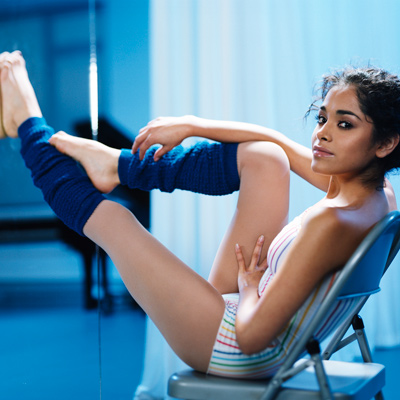
Chair dancing
Chair-dancing workout DVDs seem to have been predominantly relegated to late-night infomercials. But there's a fitness gem buried even in this risqué routine. Gyrating and jiggling is highly encouraged—and the result is tight abs, legs, butts, and more.Many private studios are beginning to incorporate these moves into their pole-dancing or other sultry dance classes.
"I tell [patients] they can then use those skills with their partner at home; they can give it as a gift on Valentine's Day," says Brandon, author of Monogamy: The Untold Story and co-author of Reclaiming Desire: 4 Keys to Finding Your Lost Libido.

Belly dancing
We love the message of this Middle Eastern dancercise: Love your body no matter what.So slip into a slinky hip wrap and shake what you've got to the lively Arabic music. Many major health clubs offer classes that can melt up to 350 calories in an hour!
Plus, for someone who's not quite comfortable swinging around a pole, this can be a more modest way to get into sexy exercising, says Brandon.

Naked yoga
Not everyone will warm to the idea of a disrobed Downward Facing Dog. Still, naked yoga studios have popped up around the country.Fans say losing their clothes makes the relaxing and calming practice even better, allowing them to really celebrate their bodies.
"The more you get to thinking about sex, the more you're going to want to have it," says Brandon. "Sexy workouts set positive expectations and help you feel more tuned into your body."
Plus, many yoga poses—done with or without clothes—open up the hips, thighs, and pelvis, and strengthen key pelvic-floor muscles for deeper and better orgasms.

Zumba
Literally translated to mean "move fast," this Colombian dance craze has swept fitness groups across six continents! It's a mile-a-minute mix of traditional aerobic moves for maximum heart pumping, sassy Latin shimmies, and hip-hop-inspired booty shaking.Best of all, you don't have to be a pro to join in the party. New participants are encouraged to hang in at their own pace, picking up the moves as they go along.
"It's not a place of competition, like you [might] expect," says Brandon. "It's very supportive for women."
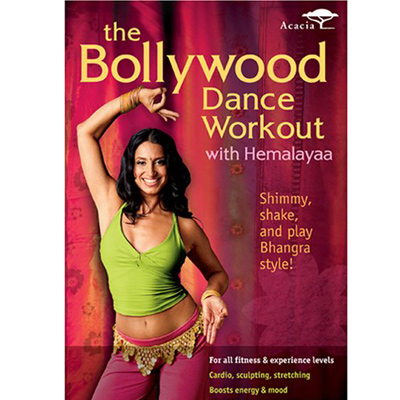
Bollywood Dance
Indian-inspired Bollywood dance is also making a sexy splash. A half hour burns about 200 calories, and many of the dances tell stories of romance or lost love, so really get into the part!If your gym doesn't offer Bollywood or Bhangra classes, there are lots of at-home options. We like Hemalayaa: Bollywood Booty

Aerial acrobatics
Popularized by circus acrobats, this workout is slowly moving mainstream. It will definitely take some practice, but learning to slink among bolts of fabric hanging from the ceiling—stretching and strengthening, all while defying gravity—is sure to take your breath away.Some private studios are now incorporating different types of antigravity movements into their classes, including yoga in midair!
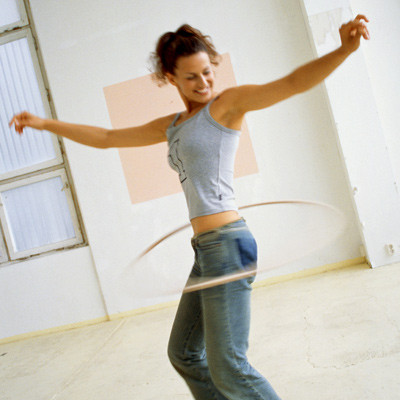
Hula-Hooping
This sport is not just for kids! Get lost in the hypnotic hip swivels of this super-fun belly blaster. Once you get comfortable with the basic how-to, you can mix and match these fun moves for a 30-minute workout that can burn up to 250 calories!You'll notice more than just the inches you lose when it comes to looking in the mirror. "It makes us feel better about our body image," says Brandon, "and that will lead us to be more interested in physical and sensual activity."
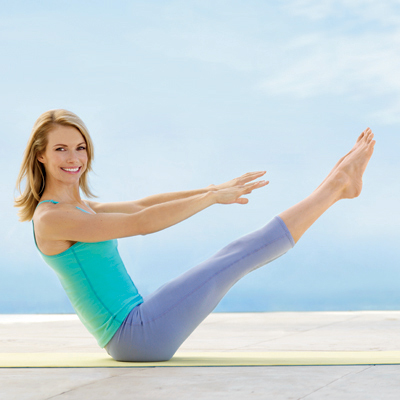
Ever caught yourself staring enviously at the toned abs and tight butt of the woman next to you in the produce section? Chances are, she’s getting help from Pilates.
Pilates is the workout to turn to for a flat tummy. A 2008 study found that Pilates mat exercises engage and strengthen the deeper ab muscles responsible for a sleek, flat stomach. But Pilates isn’t just about whittling your waistline: It can also give you exceptional whole-body toning and graceful posture, plus make your daily activities (like hoisting groceries) easier to do.
Ready to get a Pilates body of your own? We’ve partnered with New York City–based expert Kristin McGee (her clients include LeAnn Rimes and Soledad O’Brien), shown here, to bring you the ultimate 20-minute Pilates workout. Do it three times a week for a month to drop up to 6 allover inches.

Circles in the sky
For core, inner thighs, outer hips, buttLie on your back with hands behind your head. Contract abs, lifting upper body slightly off the ground. Raise right leg 5 inches (or keep it on the ground if that’s too challenging) and left leg straight up toward the sky (shown). Keeping your core engaged and hips stable, trace 4 softball-size circles clockwise with your entire left leg; reverse, circling 4 times counterclockwise. Lower both legs, switch sides, and repeat.
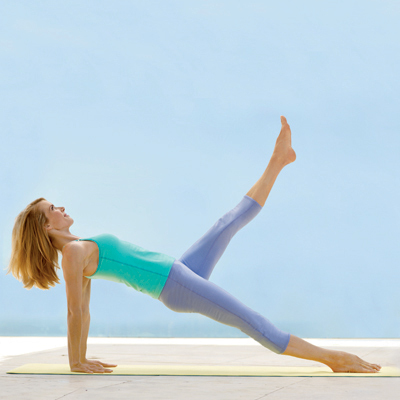
Incline plank
For triceps, biceps, chest, core, quads, hamstrings, buttFrom a seated, feet-forward position, place hands on ground slightly behind waist, fingertips facing forward. Straighten both legs, pressing heels and palms into the ground, and contract abs while lifting hips up, forming a straight line from head to toe. Keep gaze forward and shoulders pressed down; don’t lock your elbows. Lift your left leg straight up as high as you can (shown), then lower it without allowing your right hip to sag. Do 4 reps; repeat on opposite side.
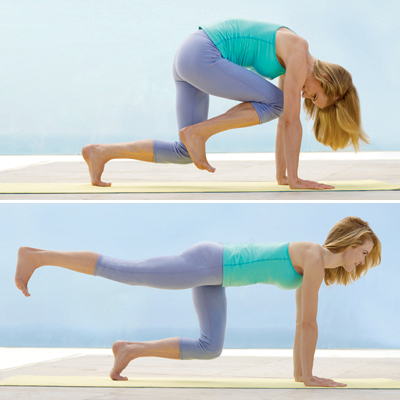
Donkey kickbacks
For triceps, biceps, core, butt, hamstrings, backKneel on all fours, toes tucked under, keeping your back neutral. Draw your belly in toward your spine as you contract your abs and lift both knees about 2 inches off the ground. Keeping abs engaged, bring right knee to nose (shown). Then kick right leg straight out behind you, squeezing your butt (shown); keep lower abs contracted and hips facing the ground to protect your back. Repeat 8 times; switch legs and repeat.

Swan dive
For triceps, shoulders, lower back; stretches abs, chestLie on your stomach, stretch your arms overhead, point your toes, and lift your arms and legs about 6 inches off the ground. Hold for 1 count, imagining your legs being pulled out and back, away from your hips. Next, circle your arms out to the sides and behind you. Exhale and reach your arms toward your toes, palms facing in (shown). Hold for 1 count, then bring arms back to starting position and relax entire body to ground. Repeat 6–8 times.
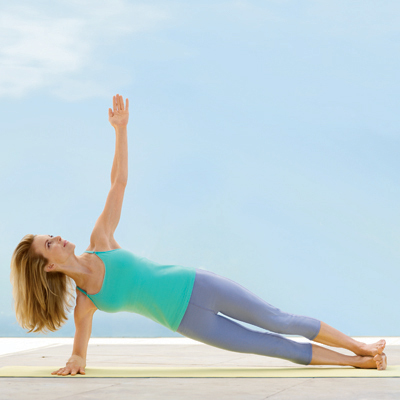
Side incline with a twist
For triceps, biceps, core, waistLie on your right side with forearm directly under shoulder, hand perpendicular to your body, and legs stacked. Engage your abs and the right side of your waist, lifting your hips so your body forms a straight line from head to feet. Extend your left arm toward the sky, staying engaged through your core (shown). Now scoop your left arm in front of your body and reach under the space between your chest and the ground, twisting only from the waist up. Come back up; repeat 4 times, then lower body to the ground. Repeat on the opposite side.
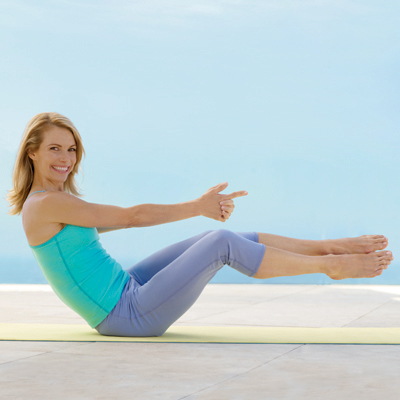
Charlie's Angels abs
For triceps, lower abs, inner thighs, hipsFrom a seated, feet-forward position, lean your upper body back while contracting your abs. Straighten arms, interlacing all fingers except your index fingers. Lift knees, forming a tabletop with shins. Keep arms pointing forward and circle knees to the right, down, to the left, and up (shown); reverse direction. (If this is too challenging, place palms on floor behind you for support.) Complete 4 circles in each direction. Maintain a 120-degree bend in knees, straightening out as you circle through the 6 o’clock position. Continuously contract abs to protect lower back. Repeat 2–4 times.
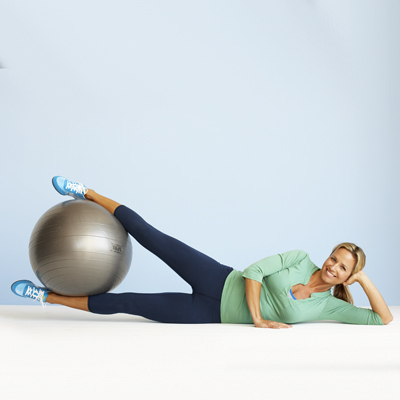
Thigh shaper
From Health magazineFor inner and outer thighs
Lie on your left side on the floor with the ball between your calves. Support your head with your left hand and balance yourself with your right hand on the floor in front of you. Squeeze the ball between your legs, slightly lifting your left leg off the floor.
Hold for a second, then relax; that’s 1 rep. Do 3 sets of 10–12 reps, resting up to 30 seconds between sets; repeat on your right side.
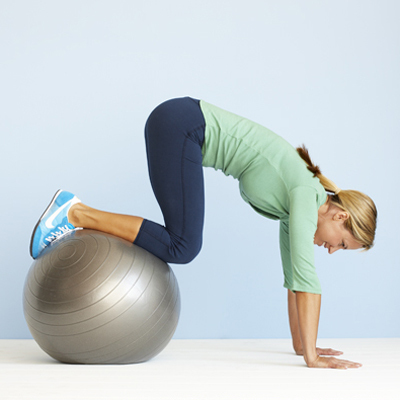
Ball pull-in
For core, chest, and shouldersA. Kneel with stability ball in front of you, then walk hands forward, rolling up on the ball until it’s beneath your shins and your body forms a straight line from your head to your feet.
B. Keep upper body stationary, and pull ball in toward chest with both legs. Return to extended position to complete 1 rep. Do 3 sets of 10–12 reps, resting for 30 seconds between sets.
Trainer tip: Keep your chin tucked throughout the move. For an extra challenge, target the muscles on the sides of your stomach by twisting your right knee toward your left side (and vice versa) when you pull the ball in.
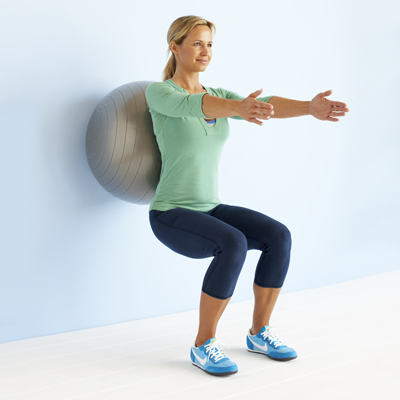
Ball squat with front raise
For butt, thighs, and shouldersA. Stand with feet shoulder-width apart and arms at your sides, pressing a stability ball between your lower back and a wall.
B. Keeping the ball pressed against the wall, squat until thighs are nearly parallel to the floor and lift arms in front of you to shoulder height. Hold this position for 2–3 seconds, then lower your arms and return to standing. Do 3 sets of 10–12 reps, holding the last rep in each set for 10–15 seconds, and resting for 30 seconds between sets.
Trainer tip: For more of a challenge, hold a 5-pound dumbbell in each hand or a 10-pound medicine ball with both hands throughout the move.
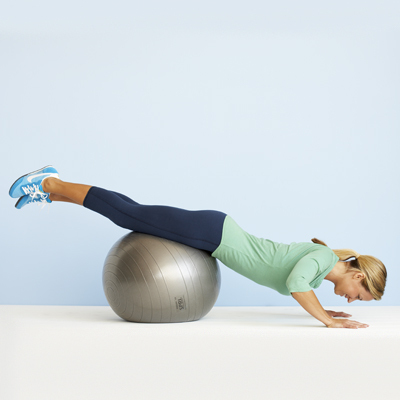
Ball push-up
For chest, core, and tricepsKneel with stability ball in front of you, then walk hands forward, rolling up on the ball until it’s beneath your thighs. (Your body should be in a straight line, with hands directly beneath your shoulders.) Bend your arms and lower your body until your nose almost touches the floor. Straighten your arms to complete 1 rep. Do 3 sets of 10–12 reps, resting for 30 seconds between sets.
Trainer tip: To protect your back, don’t let your hips sag. Mastered this move? Try it with the ball beneath your shins instead of your thighs.
The Secret to an Affordable (and Awesome!) Active Getaway
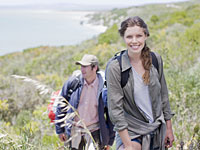
Getty Images
Truly useful get-fit tips from our senior fitness editor
By Su Reid-St. John
Dreaming about your next active vacation but don’t want to empty your wallet? Then I’ve got two words for you: state parks. In my view, these are the most overlooked destinations out there. Where else can you get lodging for your whole family for around $100 a night (sometimes a bit more, but often a lot less) with beautiful places to hike, canoe, kayak, swim, and bike, not to mention free nature programs and the best stargazing around?
And I’m not talking tents here (though you can certainly pitch those if you enjoy roughing it). Many parks offer cabins that, amenity-wise, range from bare bones (beds, table, chairs, and fire pit for cooking, with bathrooms and showers a short stroll away) to so well-stocked (bedding, dishes, full kitchen with microwave and refrigerator, shower, heat/AC, fireplace) you’d think you were crashing at a well-off friend’s rustic summer home. (Either way, you’ll need to bring your own food.)
In recent years I’ve met up with my best friend, Bren, at state parks throughout Alabama and Georgia (our two current home states) for girls’ weekends filled with some of the best hiking I’ve had the pleasure to experience. (A shout-out here to DeSoto State Park in northeast Alabama’s Little River Canyon, whose riverside and waterfall-studded trails are not to be missed.) For two summers in a row, my husband, daughter, and I stayed with my dad at Grand Isle State Park in Vermont; we managed to snag the cabin with the private beach and spent the week swimming, kayaking, and picking black raspberries. And this past summer, some college friends and my little familial trio rented three cabins side by side in the same park. It cost each family about $100 for two nights. You can’t beat that.
So pick a part of the country you’ve always wanted to visit—or stay close to home if you’re looking for a more convenient getaway—and reserve a cabin online at that particular state’s parks website. (Find it easily by typing the state name and “state park” into your favorite search engine.) And take my advice: Do it now. Like most secrets, this one’s bound to get out.
How to Stop Hating Exercise
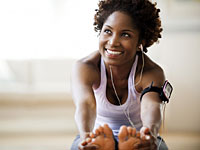
Corbis
Straight talk and savvy advice from our senior fitness editor
March 24, 2011
OK, I’m just going to say this: If you think you hate exercise, you haven’t tried the right kind.It’s like saying you hate vegetables: Surely you don’t hate them all! If Brussels sprouts make you gag, you don’t stop eating veggies altogether. You try carrots or spinach or bok choy until you find something you like.
Or think about when you’re trying on new bathing suits. If the first one makes your body look like a sausage in a too-small casing, do you stalk out of the dressing room and head for the beach naked (or not at all)? No, you try other suits.
So why should it be any different with working out? If you hate walking or running or going to the gym, fine. Don’t walk or run or go to the gym! Try swimming or tennis or qigong—and if you don’t like those, try paddleboarding or kickball or Zumba.
Here’s why it’s worth it to put in the effort: Exercise has been shown time and again to make you happier, give you more energy, help you sleep better, cut your disease risk (think diabetes, stroke, heart disease, cancer, even the common cold), help you lose weight and keep it off, increase your endurance so just living your life (lifting kids, climbing stairs, carrying groceries) feels easier…the list goes on. Talk about a wonder drug!
And if you’re thinking, OK, good point, but exercise is just so darned hard, hear this: Do it and it will get easier. It will. It’s like playing the guitar or knitting or making pie crust from scratch; it takes practice to get good at it. Our 21st-century selves are so wired for instant gratification that it’s easy to get frustrated when something challenges us. But things worth having, worth being, are worth working for.
I’m speaking from experience here. I used to hate exercise and was in pretty poor shape as a result. Then one day I saw someone whiz by on a pair of in-line skates and I thought, Wow, that actually looks like fun. So I got a pair and my world changed. To my utter amazement, I began to look forward to working out. And you know what else? The more I skated, the fitter I became—and the more I began to enjoy other activities (like hiking and biking).
What it comes down to is this: The key to finally learning to like exercise is to hang in there through all the trial-and-error and allow yourself the time and opportunity to find something you actually enjoy. And when that happens, exercise will become something you get to do, not something you have to do.
So, now, go forth and find your bliss.
Gear Guide: A Better Way to Crunch?
Our senior fitness editor tests the latest workout products—so you don't have to.
By Su Reid-St. John
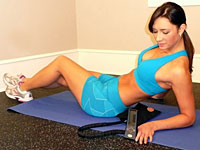
Here’s how the Abdometer works: You lie on your back with your spine in its natural (neutral) position. Put the device’s air bladder under the arch of your lower back, press a button, and voilà! It inflates to fit your body. It then monitors whether your spine is staying in the neutral position while you do your ab exercises, based on the pressure you’re putting on the bladder.
Why does that matter, you ask? For one thing, Olson says, when your body’s in proper alignment, you have better range of motion—and that makes the move more effective. Plus, you risk injuring yourself (think strained muscles, even disk damage) if your spine is in the wrong position.
Of course, I didn’t think I personally would need such a device. I’m a fitness editor; I have perfect form, right? Apparently not. I tried my usual crunch style. “Beep beep beep!” went the machine. I tried again. “Beep beep!” It took slowing down and really concentrating to get the thing to shut up. But it was worth it: I could really feel the extra effort I was putting into the movements—and my ab muscles ached the next day (always a good sign).
About the beeping: When you’re doing endurance (aka toning) exercises, the machine beeps when you’re doing something wrong. But with strengthening exercises, it beeps when you’re doing the move right. Why confuse people like that?
In any case, the Abdometer’s a handy device. Is it crucial to your workout? Nah. But if you have a spare Benjamin burning a hole in your wallet, it could be just the thing to help you get a little more oomph from your abs.
